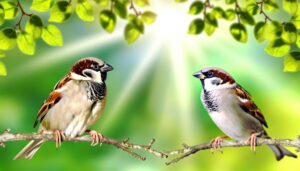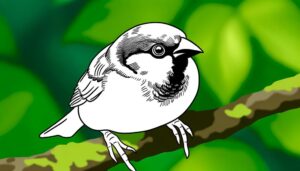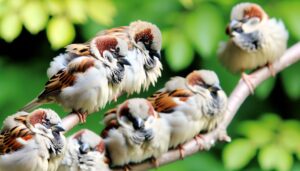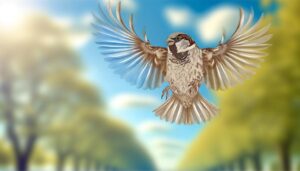Measuring Big House Sparrow: Step-by-Step Guide
House sparrows (Passer domesticus) typically measure 14 to 18 centimeters in body length, with a weight range of 24 to 40 grams. The wingspan of a house sparrow spans from 19 to 25 centimeters.
Morphological differences exist, with males generally larger than females. These variations are influenced by geographic location, environmental conditions, and diet.
Sexual dimorphism is evident, affecting weight, body length, and wingspan. These parameters are critical for ornithological studies, aiding in understanding their ecological roles and conservation needs.
For more in-depth insights, continue exploring the specific influences on their size and their ecological implications.

Key Takeaways
- House sparrows typically weigh between 24 to 40 grams.
- They average 14 to 18 centimeters in body length.
- Wingspan ranges from 19 to 25 centimeters.
- Males are slightly larger than females.
- Urban and rural sparrows may vary in size due to diet and habitat.
Understanding House Sparrow Size
To understand the size of a house sparrow (Passer domesticus), it is essential to take into account both its physical dimensions and weight, as well as its variations across different populations.
Typically, house sparrows demonstrate a weight range between 24 to 40 grams, influenced by factors such as geographic location and environmental conditions. Morphological characteristics, including wing length, bill size, and tail length, exhibit notable variability.
For instance, sparrows in urban settings may exhibit slightly different size metrics compared to rural counterparts due to variations in diet and habitat. Additionally, sexual dimorphism is evident, with males generally being marginally larger than females.
Thorough understanding requires analyzing these parameters collectively to account for the intricate variations within this widespread avian species.
Average Body Length
The average body length of a house sparrow (Passer domesticus) typically ranges from 14 to 18 centimeters. This measurement places it within the smaller spectrum of passerine birds.
Comparative analysis indicates that its body length is shorter than that of related species such as the Eurasian tree sparrow (Passer montanus), which averages around 14 to 16 centimeters.
Size Range Overview
House sparrows (Passer domesticus) typically exhibit an average body length ranging from 14 to 18 centimeters. This measurement encompasses the distance from the tip of the beak to the end of the tail, providing a standardized metric for ornithological studies.
Significantly, this size range can be influenced by factors such as geographic location, availability of resources, and overall health of the population. Male and female house sparrows generally fall within these parameters, although slight variations may occur due to sexual dimorphism.
Understanding the average body length is vital for ecological research, conservation efforts, and habitat management, as it provides insights into the species' adaptability and potential stressors in various environments.
Comparative Length Analysis
In comparative length analysis, the average body length of house sparrows is often juxtaposed with that of other passerine birds to elucidate morphological variations across species. House sparrows (Passer domesticus) typically measure around 16 cm. This length is modest when compared to other passerines such as the European starling (Sturnus vulgaris) and the American robin (Turdus migratorius). Such comparisons provide insights into ecological adaptations and evolutionary strategies.
| Species | Common Name | Average Length (cm) |
|---|---|---|
| Passer domesticus | House Sparrow | 16 |
| Sturnus vulgaris | European Starling | 21 |
| Turdus migratorius | American Robin | 25 |
| Regulus regulus | Goldcrest | 9 |
This table delineates the relative body lengths of these birds, highlighting the house sparrow's intermediate size within the passerine group.
Weight Range
The weight range of the house sparrow (Passer domesticus) typically spans from 24 to 40 grams, with an average weight of approximately 30 grams.
Variations in weight are influenced by factors such as age, sex, seasonal changes, and geographical location.
Understanding these weight dynamics is essential for ecological studies and conservation efforts.
Average Sparrow Weight
On average, a house sparrow weighs between 24 to 40 grams, depending on factors such as age, sex, and geographic location. This weight range is reflective of the species' adaptability and metabolic efficiency.
Typically, adult male house sparrows weigh slightly more than their female counterparts, with males averaging around 30 grams and females closer to 26 grams. Juveniles, due to their ongoing development, often weigh less than adults.
Geographic variation also plays a role, as sparrows in colder climates tend to have slightly higher body weights to conserve heat. The weight of a house sparrow is a critical parameter for understanding their energy requirements, reproductive health, and overall fitness in diverse environments.
Weight Variation Factors
Several factors contribute to the weight variation observed in house sparrows. These include age, sex, geographic location, and seasonal changes. Adult males typically weigh between 24-30 grams, while females generally weigh slightly less, averaging 22-28 grams. Juvenile sparrows exhibit lower weights due to ongoing growth and development.
Geographical influences, such as climate and food availability, further impact weight. Sparrows in resource-rich areas tend to weigh more. Seasonal fluctuations also play a significant role, with sparrows often gaining weight during colder months to sustain energy levels.
Understanding these factors aids in comprehending the adaptive strategies of house sparrows.
Wingspan Measurements
A house sparrow's wingspan typically ranges from 19 to 25 centimeters, reflecting its modest size and agile flight capabilities. This measurement encompasses the distance from the tip of one wing to the tip of the other when fully extended.
The wingspan is crucial for various flight behaviors, including maneuverability, speed, and energy efficiency during foraging and evasion from predators. The relatively short wingspan, compared to larger avian species, allows for quick, darting movements essential in densely vegetated habitats.
Studies indicate that the wingspan of house sparrows shows little variation between geographical populations, suggesting a stable evolutionary adaptation. Accurate wingspan measurements are essential for ornithologists conducting ecological and behavioral research on this ubiquitous urban bird species.
Male Vs Female Size
In size, male house sparrows typically exhibit slightly larger body dimensions compared to their female counterparts. Males generally measure around 16-18 grams in weight, while females average slightly less, at 14-16 grams. This dimorphism extends to body length and wingspan as well. Males often have a body length of approximately 16 centimeters, whereas females tend to be closer to 15 centimeters.
Wingspan Difference: Males typically have a wingspan of 21-25 centimeters, while females span 20-23 centimeters.
Body Mass Variation: The weight disparity, although minor, is consistent and measurable.
Ecological Impact: These size differences can affect nesting behaviors and survival strategies.
These distinctions, though subtle, play significant roles in their ecological niches and mating dynamics.
Juvenile Size
Juvenile house sparrows generally weigh between 10-12 grams and have a body length of approximately 12-14 centimeters. These measurements are indicative of their early developmental stage, where rapid growth and weight gain are vital for survival.
During this phase, their plumage is less developed compared to adults, often displaying a duller coloration which aids in camouflage. The growth rate of juvenile sparrows is influenced by factors such as food availability and parental care.
Skeletal development, particularly in the wings and legs, is pivotal for fledging, which typically occurs when they reach this size range. Monitoring juvenile size provides insights into their health and developmental progress, essential for avian biologists studying species proliferation and survival rates.
Seasonal Size Variations
Seasonal size variations in the house sparrow (Passer domesticus) are influenced by several factors, including winter plumage changes, dietary impact on body mass, and breeding season growth.
During winter, plumage density increases, potentially affecting perceived size and insulation efficacy. Additionally, fluctuations in food availability can lead to significant variations in body weight, while the breeding season often prompts physiological changes that result in temporary growth.
Winter Plumage Changes
During winter, House Sparrows exhibit notable changes in plumage density and coloration, which may be correlated with slight variations in body size and weight. The increase in plumage density serves as an adaptation to colder temperatures, providing enhanced insulation.
Observations indicate a slight increase in body mass, likely due to energy storage for thermoregulation.
- Increased feather density: Enhances insulation, vital for survival in cold climates.
- Darker plumage: May contribute to better heat absorption and camouflage.
- Slight weight gain: Supports higher energy demands in winter months.
These morphological changes are fundamental for maintaining homeostasis during harsh winter conditions. Understanding these adaptations offers insight into the species' resilience and ecological strategies, shedding light on their survival mechanisms.
Dietary Impact on Size
Fluctuations in the House Sparrow's body size throughout the year are greatly influenced by their diet, which varies in nutrient composition and availability across seasons. During spring and summer, an abundance of insects provides high protein intake, contributing to increased muscle mass and overall body size. Conversely, in autumn and winter, their diet shifts primarily to seeds and grains, which are lower in protein but higher in carbohydrates, resulting in increased fat deposits for energy storage.
| Season | Main Diet |
|---|---|
| Spring | High-protein insects |
| Summer | High-protein insects |
| Autumn | Seeds and grains |
| Winter | Seeds and grains |
These seasonal dietary changes directly impact physiological parameters, underscoring the importance of diet in avian size variations.
Breeding Season Growth
Breeding season prompts a noticeable increase in body size for house sparrows, driven by reproductive demands and associated physiological changes. During this period, sparrows exhibit measurable growth in both mass and plumage density. This seasonal size variation is attributed to several factors:
- Increased fat reserves: Essential for sustaining energy during mating and nest building.
- Enhanced muscle mass: Facilitates prolonged flights and territorial defense.
- Elevated hormone levels: Specifically testosterone, which influences overall body size and mating behaviors.
Scientific observations indicate that male sparrows may gain up to 10% of their body weight during breeding season, a critical adaptation for reproductive success.
Understanding these physiological changes during the breeding season provides insight into the adaptive strategies that secure the survival and proliferation of house sparrows.
Size Comparison With Other Birds
The house sparrow (Passer domesticus), with an average length of 16 cm and a wingspan of approximately 21 cm, is smaller than the American robin (Turdus migratorius), which measures around 25 cm in length with a wingspan of about 36 cm.
Additionally, when compared to the European starling (Sturnus vulgaris), which has an average length of 20 cm and a wingspan of 38 cm, the house sparrow remains noticeably diminutive.
Even smaller avian species like the goldcrest (Regulus regulus), with a length of 9 cm and a wingspan of 15 cm, highlight the house sparrow's intermediary size.
These comparisons underscore the house sparrow's moderate dimensions within the avian community, situating it between larger thrushes and smaller passerines.
Impact of Diet on Size
Diet plays a pivotal role in determining the size and overall health of house sparrows. Nutrient-rich diets, particularly those abundant in proteins and essential vitamins, contribute significantly to best growth and robust physiological development.
Research indicates that house sparrows with access to diverse food sources exhibit larger body sizes and enhanced immunity. Conversely, inadequate nutritional intake can result in stunted growth and increased susceptibility to diseases.
- Malnutrition: Leads to smaller size and higher mortality rates.
- Balanced Diets: Promote stronger bone structure and muscle development.
- Food Scarcity: Triggers reduced reproductive success and behavioral changes.
A thorough understanding of the diet-size relationship in house sparrows underscores the importance of environmental factors and food availability in avian population dynamics.
Size and Flight Abilities
Size directly impacts the flight capabilities of house sparrows, influencing their maneuverability, speed, and endurance. An average house sparrow (Passer domesticus) measures approximately 16 cm in length and weighs around 24-40 grams. Their relatively compact size allows for agile flight, enabling swift changes in direction to avoid predators and navigate through dense foliage.
The wing loading, a ratio of body mass to wing area, is crucial; house sparrows exhibit lower wing loading, improving their flight efficiency and endurance. Studies indicate that their maximum flight speed ranges from 29 to 40 km/h. This balanced combination of size and flight mechanics ensures that house sparrows are skilled at foraging and evading threats, essential for their survival in various habitats.
Observation Tips
Understanding the flight mechanics of house sparrows can greatly enhance your ability to observe these birds in their natural habitats. House sparrows exhibit rapid wing beats and short, direct flights, which can be essential for identifying them in the field.
Key strategies for effective observation include:
- Patience: Take time to remain still and quiet, allowing sparrows to resume their natural behavior.
- Binoculars: Use high-quality binoculars to clearly see distinguishing features such as plumage patterns and beak shape.
- Feeding Areas: Focus on common feeding spots like urban parks and gardens, where sparrows are frequently active.
Utilizing these techniques will not only improve your observation skills but also deepen your appreciation for the intricate behaviors of house sparrows.
Conclusion
The house sparrow, a veritable titan of the avian world, boasts an average body length of 16 cm, a weight range of 24-40 grams, and a wingspan of approximately 21 cm.
Males and females exhibit negligible size disparity, rendering gender-based size differentiation an exercise in futility. Compared to other birds, the house sparrow's dimensions are laughably diminutive, yet their diet and flight capabilities remain unaffected.
Observational endeavors may, as a result, proceed without fear of overlooking this minuscule marvel.






